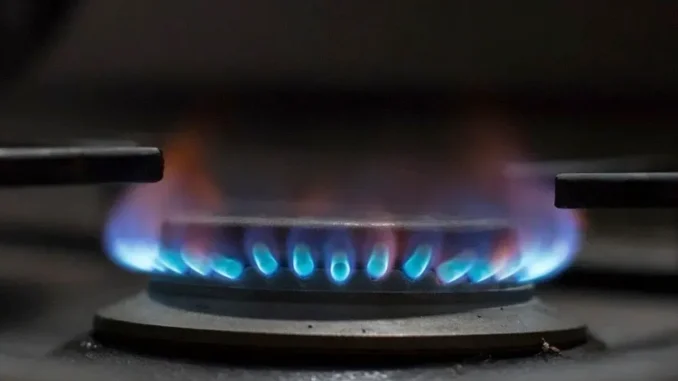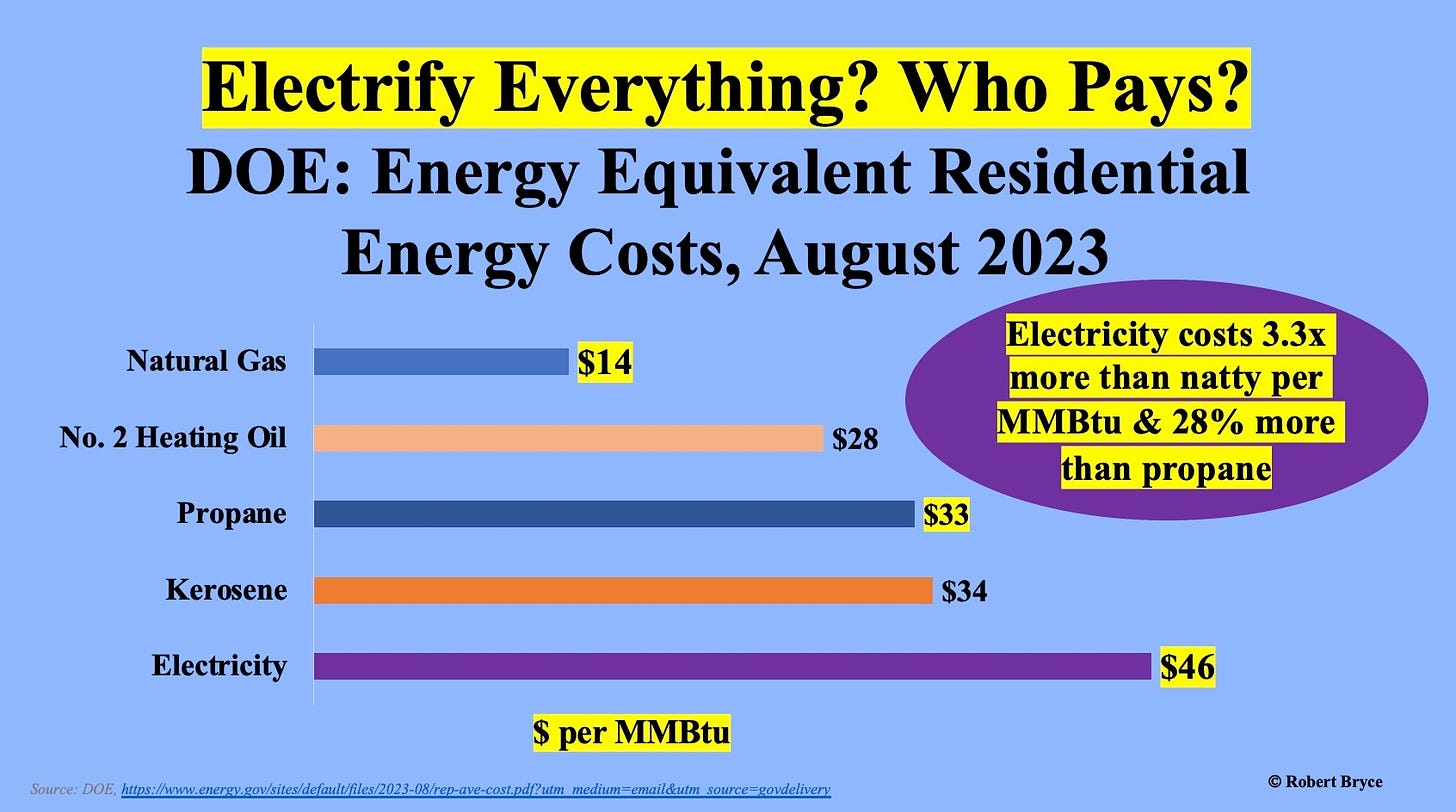
In 2022, the Biden administration held an “electrification summit” at the White House. The goal of the meeting, which included top White House officials, as well as leaders of various NGOs, including the American Federation of Teachers, Greenlining Institute, and Rewiring America — a dark-money outfit whose goal is to “electrify everything for everyone” — was to create a “strategy to accelerate affordable, equitable, and efficient electrification of American homes, businesses, and transportation.”
The same day of the summit, the White House published a “rapid innovation agenda” that touted President Biden’s goal of “a carbon pollution-free electricity grid by 2035, and to reach net-zero GHG emissions no later than 2050.” It declared that by “electrifying our homes, businesses, industry, and transportation, the United States can get more than halfway to our goal of a net-zero emissions economy by 2050.” It also claimed that electrifying everything would “lower energy costs.”
That meeting is only one example of the administration’s push to electrify everything. (The EPA’s electric vehicle mandate is another obvious example.) In June, the Department of Energy released a new definition of a “zero emissions” building. That definition stipulates that the building be “free of on-site emissions from energy use.” It doesn’t take a mechanical engineer to understand that the definition precludes using a boiler or furnace that burns hydrocarbons.
The agency claims the new definition is “not a regulatory standard.” However, it goes on to note that“Eight major green building certification programs” have agreed to “embed or align or exceed the zero emissions definition within their certification.” In other words, the DOE has adopted a definition that isn’t a regulation, but the outfits that certify green buildings are treating it like it’s a regulation.
The June move by the DOE provides yet another example of the years-long campaign to ban the direct use of gas in homes and commercial buildings. Rewiring America and other groups that get large amounts of dark money, including the Rocky Mountain Institute, which operates on an annual budget of $139 million, have been pushing the bans at the local, state, and federal levels. A particularly pernicious example of the effort to ban gas is the ballot initiative now underway in Berkeley, California. As you may recall, in 2019, Berkeley became the first city in America to impose a ban on new natural gas connections. In January, that move was declared illegal by the Ninth Circuit Court of Appeals. (See my reporting on that decision here.)
Next month, Berkeley residents will vote on a measure that could impose a draconian tax on large buildings that use natural gas. As Cal-Berkeley energy economist Severin Borenstein noted this summer, “The tax of $2.96 per therm, starting in January, would be larger than the retail price that gas consumers in Berkeley currently pay, about $2.33/therm.”
These proposed bans, mandates, and taxes matter because they directly impact consumers and the prices they pay for energy. Under the Energy Policy and Conservation Act of 1975, the DOE must publish the representative average costs of five residential energy sources every year, including natural gas and electricity. As I explained three years ago in Forbes and again in August 2023, the DOE’s cost figures show that “the electrify everything push is, in reality, a regressive tax.”

Last August, the DOE published the residential cost figures. As seen above, those figures showed that natural gas costs far less than electricity on an energy-equivalent basis. As I explained, the DOE’s numbers showed that:
On an energy-equivalent basis, electricity will cost 3.3 times more than natural gas this year. The forecast found that electricity will cost about $46 per million Btu while natural gas will cost about $14. The DOE numbers…gut the claims being made by NGOs, and in the White House press releases, that the electrify everything push will “lower energy costs.” The exact opposite is true.
Now to the purpose of this article: Although EPCA requires the DOE to do so, the agency still hasn’t published the cost figures for 2024. That’s a troubling turn of events.
The list below shows that the agency usually publishes the cost figures in March or April. Since 2011, it has waited until August on two occasions.
- In 2011, the costs were published on March 7.
- In 2012, the costs were published on April 26.
- In 2013, the costs were published on March 22.
- In 2014, the costs were published on March 18.
- In 2015, the costs were published on March 23.
- In 2016, the costs were published on March 23.
- In 2017, the costs were published on May 5.
- In 2018, the costs were published on April 23.
- In 2019, the costs were published on March 8.
- In 2020, the costs were published on August 14.
- In 2021, the costs were published on March 17.
- In 2022, the costs were published on March 7.
- In 2023, the costs were published on August 28.
Given my long interest in energy prices, I emailed the DOE on August 8 to inquire about the status of the 2024 cost figures. I did not get a reply until I followed up with the agency on August 22.
On August 27, an unnamed media person in the Office of Energy Efficiency and Renewable Energy emailed to say it is working to have the “new version available as soon as possible.” That same day, the agency’s point person on the cost figures, Nick Montoni, emailed to say, “The newest version is in the works and they will be publishing it ASAP. “ I waited a month for Montoni to follow through.
He didn’t.
On September 24, I inquired again. Montoni replied to my email, saying the team was “still finalizing the updates” and that he would let me know when the information was published. Montoni has not replied to subsequent emails, including one I sent on October 1.
The DOE’s lack of accountability on this critical matter is unfortunate.
In 2021, the Biden administration promised to set “an example of engagement and transparency.” On September 25, during a campaign speech in Pennsylvania, Vice President Kamala Harris said that we “should seek practical solutions to problems, realistic assessments of what is working and what is not, applying metrics to our analysis, applying facts to our analysis.”
So why isn’t the DOE publishing the facts (and cost figures) so that we can apply “metrics to our analysis?” The simplest explanation is that the agency doesn’t want the public to understand the cost or regressive nature of its electrify everything agenda. That’s particularly true now, given that electricity prices are soaring. In July, the Bank of America Institute estimated that electricity prices have increased by about 6% this year. And those prices will continue rising in the years ahead.
The unfortunate punchline here is obvious: the DOE has politicized its legally required reporting requirements. It refuses to publish the residential energy price data because the numbers will be embarrassing for the DOE and the Biden Administration at the very moment Vice President Harris is vying to be the next president.
I may be mistaken about this. But until the DOE proves me wrong by publishing the residential cost figures, I will remain convinced that the agency is stonewalling because the new residential energy cost figures will show, once again, that the electrify everything push is yet another regressive decarbonization policy that will impose higher energy costs on the poor and middle class.
Source: Robertbryce.substack.com
We give you energy news and help invest in energy projects too, click here to learn more




Be the first to comment